Typhoid Fever Shot: Prevention, Treatment, and Role of Zylomox
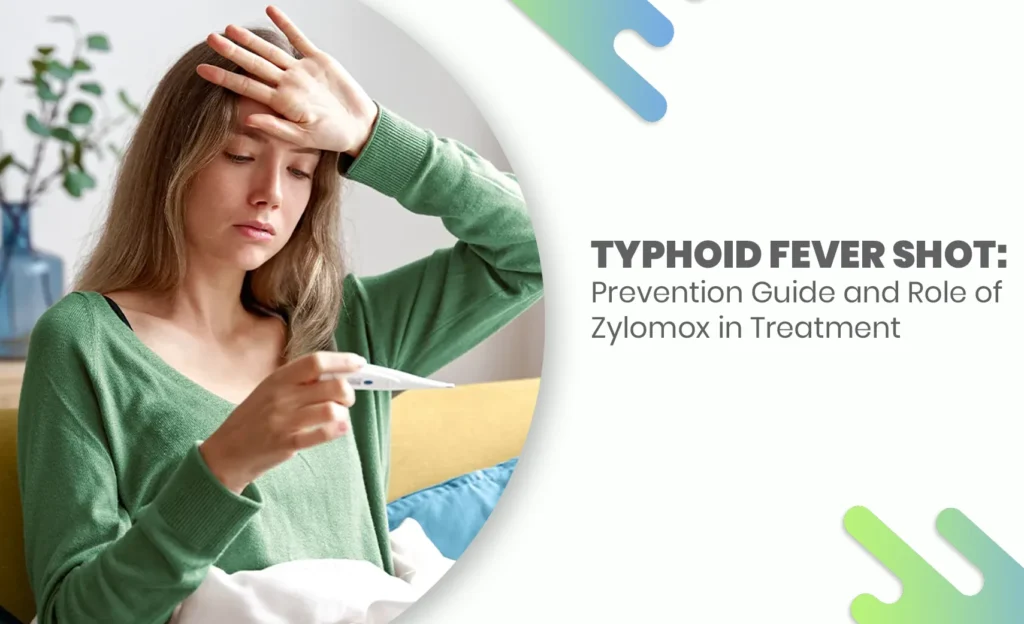
Typhoid fever remains a serious public health concern, especially in regions where clean water and sanitation are limited. This bacterial illness, caused by Salmonella Typhi infection, continues to affect millions each year and poses significant risks for both local populations and international travelers. Despite major advances in disease control and vaccination programs, rising cases in endemic typhoid areas highlight the urgent need for comprehensive prevention and treatment strategies.
For many travelers, pre-travel immunization is strongly recommended. A typhoid shot is one of the most common forms of typhoid fever vaccination, offering essential protection before visiting high-risk regions. While typhoid immunization plays a central role in foodborne illness prevention and helps reduce transmission, it is not 100% protective. Typhoid vaccine efficacy varies, and breakthrough infections can occur, making typhoid prevention strategies a blend of travel vaccination, safe food practices, and timely medical care.
This is where antibiotic treatment for typhoid becomes vital. Even with typhoid immunization, individuals may still contract enteric fever, requiring effective therapy. Among the widely used options, Zylomox antibiotic therapy, particularly Zylomox 500mg—remains an important part of clinical management. Understanding the Zylomox mechanism of action and its role in combating Salmonella Typhi infection helps explain why both typhoid fever prevention through vaccination and therapeutic intervention through antibiotics are necessary.
In this article, we’ll explore how typhoid prevention strategies such as typhoid fever vaccination, booster schedules, and hygiene measures intersect with treatment protocols like Zylomox typhoid treatment. Together, these approaches form the foundation for reducing typhoid fever symptoms, improving treatment outcomes, and advancing global epidemiological control.
Understanding Typhoid Fever
Typhoid fever, also known as enteric fever, is a serious bacterial illness caused by the Salmonella Typhi infection. It continues to be a significant threat in many endemic typhoid areas, where poor sanitation and limited access to clean drinking water contribute to its spread. For travelers, typhoid is often considered a key concern in travel medicine, making awareness and typhoid fever prevention strategies essential.
The disease spreads primarily through contaminated food and water, making it part of the larger category of foodborne illness prevention challenges. In areas with inadequate waste disposal and hygiene practices, outbreaks can spread rapidly, requiring strong public health measures and typhoid surveillance to control transmission.

Recognizing typhoid fever symptoms early is crucial for effective clinical management. Typical signs include high fever, severe abdominal pain, headache, and fatigue. Some patients may develop a faint rose-colored rash on the chest or abdomen. Gastrointestinal symptoms vary, with some experiencing diarrhea, while others develop constipation. Because these symptoms resemble other illnesses, typhoid fever diagnosis often relies on laboratory testing for typhoid, including blood culture and occasionally the Widal test, to confirm infection.
If left untreated, typhoid fever can lead to severe typhoid complications, such as intestinal perforation, internal bleeding, and systemic infection, all of which pose life-threatening risks. This is why early medical consultation, accurate risk assessment, and prompt therapeutic intervention with appropriate typhoid fever medication, such as Zylomox antibiotic therapy are critical in reducing morbidity and mortality.
Prevention Through Typhoid Fever Shots
When it comes to typhoid fever prevention, the most effective tool remains typhoid fever vaccination. A typhoid shot helps the body develop immunity against Salmonella Typhi infection, lowering the risk of illness in high-risk regions. In travel medicine, pre-travel immunization is considered a cornerstone of typhoid prevention strategies, especially for those heading to endemic typhoid areas.
There are two main types of vaccines currently in use:
- Inactivated vaccine (Typhim VI – injection): Administered as a single intramuscular dose, this form of typhoid immunization is recommended for adults and children over the age of 2.
- Live attenuated vaccine (Vivotif – oral capsules): Taken in a series of doses, this oral option provides protection for older children and adults. Because it contains a weakened strain of the bacteria, it is not suitable for immunocompromised individuals or pregnant women.
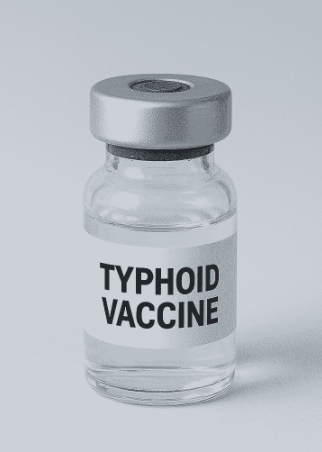
Who should get vaccinated?
- Travelers visiting regions with poor sanitation or high incidence of typhoid.
- Laboratory workers handling Salmonella Typhi.
- Residents of or frequent visitors to endemic typhoid areas.
When to take the shot?
Timing is crucial. The vaccine should be administered at least 1–2 weeks before travel to ensure the body develops adequate protection. A proper vaccine schedule is also important, booster shots are often recommended every 2 to 5 years, depending on the vaccine type and exposure risk. This helps maintain long-term immunity and improves typhoid vaccine efficacy.
Limitations of typhoid vaccines:
While typhoid immunization significantly reduces the risk of illness, no vaccine is 100% effective. Breakthrough cases may still occur, especially in areas with high bacterial loads. For this reason, typhoid prevention strategies must also include safe food practices, clean drinking water, and strong public health measures. Combining vaccination programs with good hygiene and timely medical consultation ensures better disease control and protection against typhoid.
Common Side Effects & Precautions of the Typhoid Shot
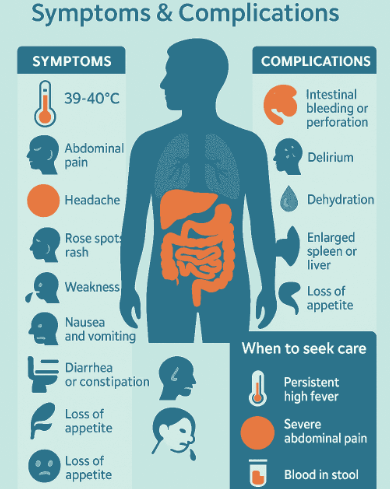
Like most vaccines, the typhoid shot is generally safe, but it can cause mild side effects as the body builds immunity. After typhoid fever vaccination, many people experience short-term reactions such as:
- Low-grade fever
- Headache or muscle aches
- Injection site reactions like redness, swelling, or mild pain
These effects are usually temporary and resolve within a few days without treatment.
In rare cases, more serious reactions may occur. Severe allergic responses, difficulty breathing, or significant swelling around the face and throat require immediate medical consultation. Such events are uncommon but highlight the importance of following proper healthcare guidelines and reporting unusual symptoms to a doctor.
Who should avoid or delay typhoid immunization?
Certain groups may need to postpone or avoid specific vaccine types:
- Children under 2 years old should not receive the inactivated injectable vaccine.
- Immunocompromised individuals and pregnant women should generally avoid the live oral vaccine (Vivotif), since it contains a weakened form of Salmonella Typhi infection.
- Patients with an acute illness or fever may be advised to wait until recovery before vaccination.
Medication Interactions: A Key Consideration
A frequently overlooked area in typhoid prevention strategies is how the vaccine interacts with other pharmaceutical interventions. For instance, patients sometimes ask: Can antibiotics like Zylomox interfere with typhoid vaccines?
- In most cases, antibiotics such as Zylomox 500mg do not reduce typhoid vaccine efficacy when the injectable (Typhim VI) is used.
- However, when it comes to the live attenuated oral vaccine (Vivotif), concurrent antibiotic treatment for typhoid or other infections may kill the weakened bacteria in the capsules, reducing the vaccine’s protective effect.
- This makes it essential to discuss any ongoing drug therapy, including Zylomox antibiotic therapy, with a healthcare provider before starting a vaccine schedule.
By understanding these precautions, individuals can ensure safe typhoid fever prevention while avoiding potential issues with therapeutic intervention or medication adherence.
Treatment of Typhoid Fever: The Role of Zylomox
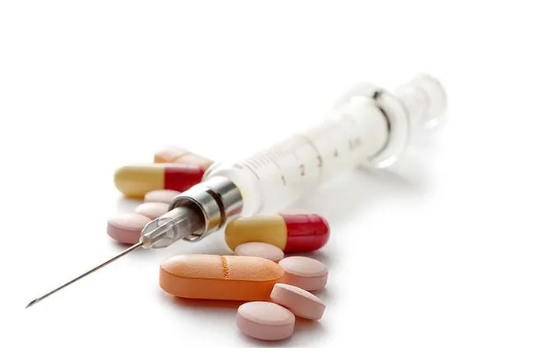
Even with typhoid fever vaccination, infections can still occur because no vaccine offers 100% protection. This is why antibiotic treatment for typhoid remains essential in clinical management, particularly in patients who develop full-blown typhoid fever symptoms after exposure in endemic typhoid areas. Vaccination reduces overall risk, but prompt therapeutic intervention with the right typhoid fever medication is what saves lives.
Zylomox (Amoxicillin) for Typhoid
Zylomox, a widely prescribed form of amoxicillin, is frequently used in Zylomox typhoid treatment due to its effectiveness against Salmonella Typhi infection.
- Zylomox mechanism of action: It works by inhibiting bacterial cell wall synthesis, ultimately killing the bacteria and stopping the infection.
- Dosage forms: Available in Zylomox 500mg tablets, capsules, and oral suspensions, making it suitable for both adults and children.
- Treatment protocols: The typical treatment course lasts 7–14 days, depending on the severity of illness and typhoid fever diagnosis confirmed through blood culture or the Widal test.
Alternatives to Zylomox
While Zylomox antibiotic therapy remains a frontline option, doctors may prescribe other typhoid fever medications in cases of allergy, intolerance, or resistance. Alternatives include:
- Azithromycin – often used for uncomplicated cases and resistant strains.
- Ceftriaxone – a powerful injectable option, typically for hospitalized patients.
- Ciprofloxacin – previously common, but now limited due to widespread drug-resistant typhoid.
Antibiotic Resistance Challenges
The rise of antibiotic resistance is a growing concern in pharmaceutical intervention for typhoid. In many regions, strains of Salmonella Typhi have developed resistance to older drugs, limiting treatment options and complicating clinical trials and treatment outcomes. This makes proper risk assessment, typhoid surveillance, and adherence to updated healthcare guidelines critical.
Why Completing the Full Course Matters
One of the most important aspects of Zylomox antibiotic therapy is medication adherence. Stopping treatment too early can lead to relapse, persistent infection, and greater risk of resistance. Completing the full prescribed course ensures effective bacterial clearance and reduces the likelihood of severe typhoid complications, such as intestinal perforation.
While typhoid immunization through a typhoid shot provides valuable protection, Zylomox 500mg and other antibiotics remain indispensable in typhoid prevention strategies and clinical management. Combining prophylactic treatment through vaccination with effective drug therapy is the most reliable way to achieve positive treatment outcomes.
Prevention + Treatment: A Combined Strategy
When it comes to typhoid fever prevention, neither a typhoid shot nor antibiotic treatment for typhoid alone is enough. Vaccination through typhoid immunization provides partial protection by reducing the risk of infection, while Zylomox typhoid treatment and other antibiotics play a critical role in therapeutic intervention once illness develops. A combined approach, vaccination, safe practices, and timely drug therapy, all these offer the best defense against Salmonella Typhi infection.
Safe Travel Checklist
For anyone heading to endemic typhoid areas, especially travelers and aid workers, following a practical prevention and treatment plan is essential:
- Get Vaccinated
- Schedule pre-travel immunization at least 1–2 weeks before departure.
- Follow the recommended vaccine schedule and booster shots for long-term protection.
- Understand typhoid vaccine efficacy, while effective, it is not foolproof.
- Schedule pre-travel immunization at least 1–2 weeks before departure.
- Carry Prescribed Antibiotics
- Ask your doctor about having Zylomox 500mg or other typhoid fever medication available for emergencies.
- This prophylactic treatment approach ensures access to prompt therapy if symptoms begin while abroad.
- Always follow treatment protocols under medical supervision to avoid misuse and antibiotic resistance.
- Ask your doctor about having Zylomox 500mg or other typhoid fever medication available for emergencies.
- Follow Strict Hygiene Practices
- Drink only boiled or bottled water.
- Avoid raw or undercooked foods and stick to freshly cooked meals.
- Wash hands frequently with soap and water, especially before eating.
- These typhoid prevention strategies reduce exposure to contaminated food and water, complementing vaccination programs.
- Drink only boiled or bottled water.
- Know When to Seek Urgent Care
- If you develop persistent fever, severe abdominal pain, or notice blood in stool, seek immediate medical consultation.
- Early diagnosis using laboratory testing for typhoid (such as blood culture) ensures faster clinical management and better treatment outcomes.
- If you develop persistent fever, severe abdominal pain, or notice blood in stool, seek immediate medical consultation.
Long-Term Protection Against Typhoid
Typhoid fever is not just a short-term travel concern, it remains a public health challenge in many parts of the world. Ensuring long-term protection requires a mix of vaccine boosters, monitoring for antibiotic resistance, and strengthening community-based prevention programs.
Booster Doses: Who Needs Them?
The protection offered by the typhoid vaccine fades over time, which is why booster doses are necessary:
- Injectable Vi polysaccharide vaccine: A booster shot is recommended every 2 years for people at continued risk.
- Oral Ty21a vaccine: Requires a booster every 5 years for those traveling or living in typhoid endemic areas.
- High-risk groups such as healthcare workers, aid volunteers, and frequent travelers should always stay updated on their immunization schedule to maintain strong vaccine efficacy.
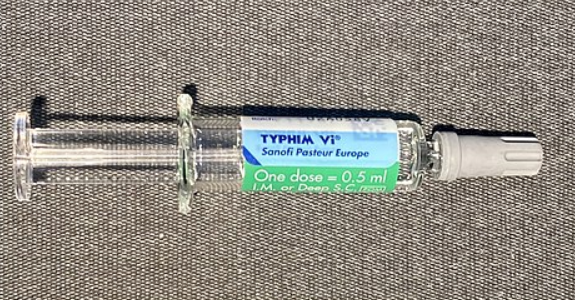
Monitoring Antibiotic Resistance Trends
Even with vaccination, antibiotics like Zylomox (Amoxicillin) remain crucial for typhoid treatment. However, rising antimicrobial resistance is a growing concern:
- Strains resistant to amoxicillin, ciprofloxacin, and ceftriaxone are emerging in many regions.
- Continuous resistance surveillance helps guide appropriate treatment protocols and prevents the misuse of antibiotics.
- Public health agencies stress the importance of completing the full course of Zylomox or any prescribed therapy to reduce the risk of resistant strains developing.
Role of Public Health Measures
For lasting protection, individual care must be paired with community interventions:
- Improving sanitation infrastructure and access to clean drinking water.
- Educating communities on handwashing, safe food handling, and hygiene practices.
- Strengthening vaccination programs in schools and high-risk populations.
- Conducting epidemiological monitoring to track outbreaks and inform disease control strategies.
In the long run, the fight against typhoid depends on a combined effort, personal protection through vaccination and antibiotics, and large-scale public health measures that reduce transmission at the source.
Conclusion
Typhoid fever prevention is a multi-layered effort. While typhoid fever vaccination significantly lowers the risk of infection, no typhoid immunization provides complete protection. This is why awareness of typhoid prevention strategies, such as safe food and water practices, hygiene, and timely medical care remains critical.
For those who do contract Salmonella Typhi infection, Zylomox (Amoxicillin) continues to play a vital role as a frontline antibiotic treatment for typhoid. Its proven clinical management benefits, when used at the right dosage forms and completed as prescribed, help ensure successful recovery and reduce complications.
The most effective strategy is a combined approach, pairing vaccination programs, good hygiene, and early access to typhoid fever medication like Zylomox 500mg. Together, these measures form a powerful shield against both enteric fever and the long-term threat of drug-resistant typhoid.
Always consult your healthcare provider or a travel medicine specialist to determine the right vaccine schedule and treatment plan tailored to your risk level and travel needs. Staying proactive with typhoid surveillance, health education, and safe practices is the key to long-term protection.
FAQs
Q1. What is the vaccine used to prevent typhoid fever?
The two main vaccines currently licensed for use, Ty21a and Vi polysaccharide, were effective in reducing typhoid fever in adults and children over two years in endemic countries; adverse events such as nausea, vomiting, and fever were rare.
Q2. Is the typhoid vaccine preventative?Typhoid vaccine can prevent typhoid fever. People who are actively ill with typhoid fever and people who are carriers of the bacteria that cause typhoid fever can both spread the bacteria to other people.
Q3. What is the prevention and control of typhoid fever?
Access to safe water and adequate sanitation, hygiene among food handlers and typhoid vaccination are all effective in preventing typhoid fever.
Q4. Do Americans get the typhoid vaccine?
No, Americans do not routinely get the typhoid vaccine, but it is recommended for those traveling to areas where typhoid is common, such as parts of Asia, Africa, and Central/South America. It’s also recommended for people who work in laboratories with Salmonella typhi bacteria or who are in close contact with someone who has typhoid. Two types of vaccines are available: an injectable shot and a live oral vaccine.
Q5. Who should not get the typhoid vaccine?
Typhoid vaccine contraindications include a history of severe allergic reaction to the vaccine or its components, a weakened immune system (for live oral vaccines like Ty21a), pregnancy (for the live oral vaccine), and the current use of antibiotics that could interfere with the live oral vaccine’s effectiveness. Vaccination should be postponed in people with fever or recent illness, such as vomiting or diarrhea, until they recover.


